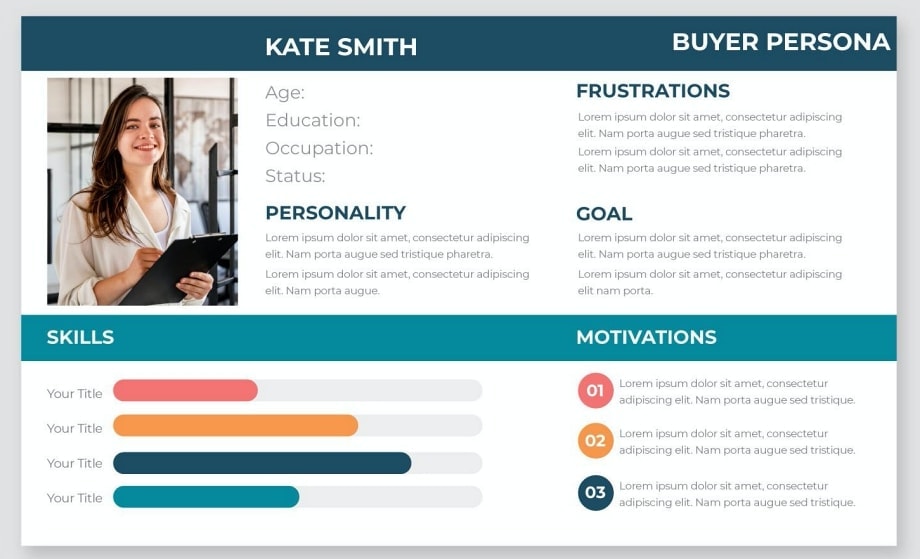One of the basics of any marketing strategy is understanding the target consumer the brand wants to reach. Defining a buyer persona (aka. customer persona, audience persona, or marketing persona) helps you target the perfect customer that wants to buy your products or services. A good persona also helps your brand's marketing campaigns reflect the target's personality and interests.
In this guide, we will walk you through the definitions and examples of how to create a buyer persona for your next marketing campaign.

What Is a Buyer Persona
A buyer persona is a fictional image of someone who represents your target audience. A made-up character who embodies the characteristics of your ideal customers based on data and research. They help you focus your strategy and resources on the best potential prospects, guide your brand's marketing communication, and put everyone across your organization on the same page.
A buyer persona's goal is for you to think about and speak to this imaginary consumer as if they were real. This made-up person generally has a name, demographic details, interests, and behavioural traits.
A well-thought-out buyer persona helps you understand their goals, pain points, and buying patterns, allowing you to craft marketing messages targeted specifically to them. Your buyer persona will guide you through every step, from product development to your brand voice to the social channels you use.
Since different people make purchase decisions based on various reasons, you might need more than one persona to cover that other consumer segment.

How to Create a Buyer Persona
Do an intensive audience research
The first step to creating a persona is gathering data about your target consumer and then compiling that information to pinpoint who you want to turn into customers.
The data should include details like:
Age
Location
Language
Interests
Spending power and patterns
Incentives to purchase decisions
Pain points
Stage of life
This information will form the basis for creating buyer personas. To gather this information, you can spread questionnaires on social media that the target uses, or invest in thorough, systematic market research for more accurate and reliable results.
Identify the goals and obstacles
An essential part of creating personas is understanding the purpose in life, worries, and fears that the character has. Marketers can work on that information to plan marketing campaigns that will resonate with the target consumer’s preferences, fulfilling their goals, or eliminating their fears.
Having the goals and obstacles set, marketers can solve consumer problems and understand what they want from the brand.
Positioning the persona
Once you have gathered the information, try formulating a backstory for this persona and give it a name. This might sound absurd. But trust me, it is an essential psychological cue to make marketers feel like they are talking to a real person, not a pile of made-up numbers. This way, they can understand the target consumer segment they want to communicate with better.
Answer questions like their daily routine, what kind of work they do, what they do and where they go in their free time.
This backstory helps understand the target audience’s behaviour and mentality, and it builds a stronger foundation to plan marketing strategies based on their spending patterns.
Formulate demographic data
Once you know what the target does in a day, try incorporating demographic data gathered in the first step into your previously created backstory. This will help marketers see the persona’s slice of life outside of work, more on the personal, intimate side. The data helps decide which communication directions will reach this segment of consumers.
Try to capture consumer insights based on what you learn from sharing with the persona, and incorporate them into concepts for your next marketing communication strategies.
Create your buyer persona
Collect all of your research and begin building your persona. Try to include the amount of information you would expect to see on a dating site. Don't forget to include pain points and goals. Remember, a list of traits does not equal a persona. A persona is a realistic description of a person who represents one segment of your customer base.
Buyer Persona Example
Let’s say your brand sells shoes via an online store. You identify a core customer group of office women in their 30s who live in urban areas like to shop for shoes online. Great—now it’s time to take this abstract collection of traits and turn them into a buyer persona that you can relate with.
For example, your group of online-shopping urban office women could be represented by the persona named Kate Smith. Based on research, you’ll give Kate representative characteristics that make her a real person:
She is 36 years old
She has two kids, aged 4 and 1
She lives in Los Angeles, CA
She works as a receptionist with $38k income
She turned to online shopping to avoid the hassle of shopping in stores.
She would like to buy several pairs of shoes to fit different occasions and styles.
She can rarely find a pair that fits her narrow feet.

Sure, not all people in this consumer segment match the characteristics of your persona exactly. But this persona represents this customer group to you and allows you to think about them in a human way rather than as a collection of data points.
It’s a lot easier to speak to Kate than it is to speak to “women.” Or even “36-year-old urban office women who buy shoes online.”
As you flesh out your customer personas, be sure to describe both who each persona is now and who they want to be. This allows you to start thinking about how your products and services can help them get to that place of ambition.

Frequently Asked Questions
Why should I create a buyer persona?
Buyer personas let you better understand your customers' needs and wants better. This will allow you to do a more efficient job of appealing to their specific desires. This is a crucial tool in tailoring your marketing efforts toward the right people in lead generation.
What is an example of a persona?
A business persona is about perception. Let's look at an example: if a businessman wants others to think that he is very powerful and successful, he might buy a big house, drive a fancy car, and talk to people who are below him on the social ladder.
What is the difference between an ideal customer profile and a buyer persona?
Buyer personas define specific sorts of leads and prospects in that market, while ideal customer profiles broadly describe a target existing customers.
How many buyer personas should I have?
In most cases, it's generally accepted that 3-8 personas are sufficient. If your business is targeting multiple industries or verticals, you definitely want to have a unique buyer persona for each one.
Who will buyer personas benefit the most?
All customer-facing teams will benefit from this tool because it can provide value to marketing, sales, and services.
What are the three stages of the buyer's journey?
The buying process consists of three main steps: awareness, consideration and decision. The buyer's journey allows companies to fine-tune their marketing strategies to attract the optimal target audience for their product or service.
Need Digital Marketing Aid For Your Own Brand?
Need a hand? Our team at Sphere Agency can help you plan the most effective 4P Digital Marketing Strategy that fits with your goal and KPI in the years to come. See our Digital Marketing Services and Contact us today!





